Cat tricks are all about engaging your kitty’s curious nature, agile body, and super-sharp mind. It’s a great, fun way of training your cat to show desired behaviors and improve the bond between you.
Cat tricks can be divided into basic, intermediate, and advanced levels and can include simple commands, such as coming to call, “sit,” “high-five,” and touching a target stick. Intermediate tricks include walking through a tunnel, spinning in a circle, and fetching a toy, while advanced tricks include walking on a leash, turning off a light switch, and even using a human toilet!
Teaching tricks to cats is important because it helps to train your cat to behave well around your home and can modify undesirable behaviors through play and positive reinforcement training. Essentially, cat trick training helps to build a strong bond between you and your pet while providing her with mental and physical stimulation and exercise.
Read this comprehensive guide to learn how to teach 30 great tricks to your cat and more!
30 Cat Tricks To Teach Your Cat
In this section of our guide, you can learn how to train your cat to perform 30 impressive tricks!
Start by teaching your cat some basic, simple commands and cues, and then move on to have her perform more complicated, challenging tricks that will astound and impress your friends and family!
The tricks we’ve included in our guide have been categorized as basic, intermediate, and advanced. Always begin with the simplest, basic tricks, work your way to more difficult intermediate ones, and finish by teaching your cat the most advanced, challenging ones on the list.
The tricks are ordered specifically to allow your cat to grasp the basics before making gradual progress through to the most difficult commands. That helps to keep the process fun and prevents your cat from becoming stressed.
Basic Tricks For Cats
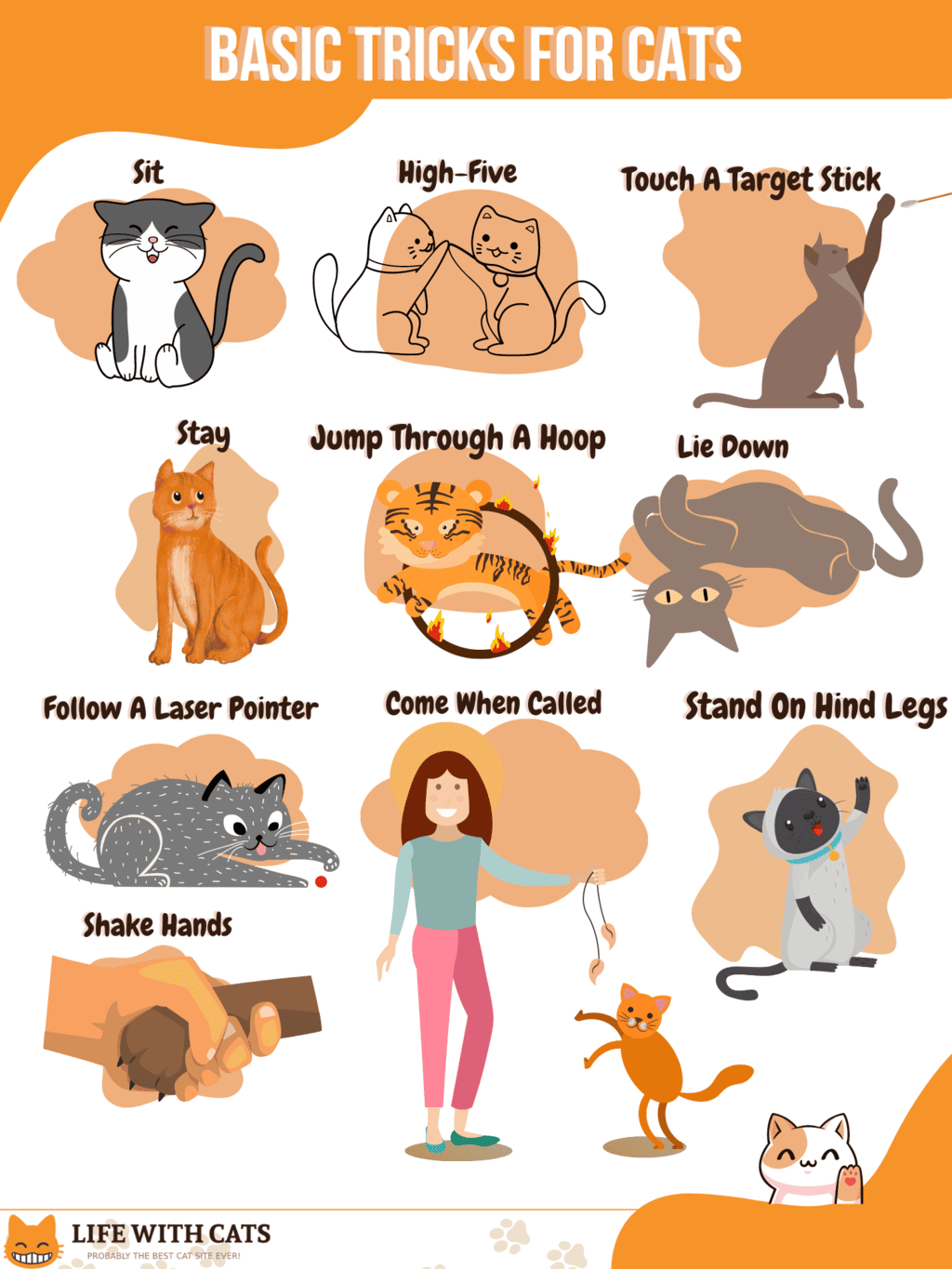
Basic tricks for cats are simple commands that you can teach your pet to improve and modify her behavior around your home.
Sit
Teaching your cat to sit on command is a basic trick that’s quite easy to teach.
- Hold a treat in your hand and allow your cat to smell it.
- Slowly lift the treat over your cat’s head toward her back, keeping it just out of reach.
- The cat will follow the treat with her eyes, automatically sitting down.
- As you move the treat, use the command “Sit” to help your cat associate the command word with the action.
- Immediately your cat sits down, praise her verbally and offer the treat as a reward.
- Repeat the exercise, then start using the command word without moving the treat over the cat’s head. Eventually, she will sit on command.
Stay
The “Stay” command instructs your cat to remain where she is, only coming to you or moving off when you call her.
- Ask the cat to sit and stay in a particular place. As soon as the cat stays in one place for a few seconds, reward her with treats and verbal praise.
- Gradually increase the duration and distance of the stay command, taking a step backward and using your verbal command. If the cat remains in place, praise her and give her a treat.
- Over time, increase the distance and duration of the stay command, using positive reinforcement to show your cat she’s getting it right.
High-Five

The high-five trick involves your cat sitting and raising a paw to touch your opposite hand.
- Show your cat a target stick and allow her to sniff it, offering a reward so that the cat associates the target stick with something positive.
- Present the target to your cat, rewarding her with a treat whenever she touches it. Repeat the process so that the cat begins associating the target with treats.
- Now, introduce a hand signal, such as raising your hand for the cat to touch. Present the target stick and raise your hand at the same time.
- Reward her immediately when the cat touches the target in response to the high-five motion.
- Gradually remove the target stick so that your cat only responds to the high-five signal.
Come When Called
Having your cat come when called is a handy trick for owners who want to get their cats in at night.
- Start by using your cue word, such as your cat’s name or “Kitty come,” and give your cat a treat or some other reward she loves. That way, your cat learns to associate good things with coming when you call her.
- Repeat the exercise, shaking the treat bag to build a sense of anticipation in your pet.
- Once your cat gets the idea, call her from different rooms in your home, gradually phasing out the treats until your cat comes to call wherever you are and whenever you want her.
Touch A Target Stick
This trick is integral to many other cat tricks, so teaching it to your cat early in your training program is important.
- Hold your target stick in front of your cat a few inches away from her nose. When your cat touches the ball at the end of the stick, give her a treat, and click your clicker if you’re using one.
- If the cat doesn’t sniff the target, rub a treat on the end of the target stick and try again.
- Keep repeating the exercise; only treat your cat when she touches the end of the target stick.
- Gradually move the stick further away from your cat inch by inch, and try moving it in different directions, clicking and rewarding your cat for every successful target.
Follow A Laser Pointer
My cats love this trick and find it incredibly easy! This trick works best in a darkened room and if you keep the light low down where the cat can see it.
- Aim the laser pointer at the floor just in front of your cat so she can see the light, then move it away slowly. Your cat should chase the light and pounce on it!
- Every time your cat chases and tries to catch the light, reward her with a treat.
Jump Through A Hoop

Cats are agile and athletic creatures, so asking your kitty to jump through a hoop is actually quite an easy trick for your pet to learn!
Choose a large hoop that your cat can easily fit through, such as a kid’s hula hoop, although you can buy dog agility hoops on stands that are perfect.
- Let your cat check out the hoop. Once your pet is freely approaching the hoop and walking around it, reward her with treats.
- Keep the hoop in contact with the ground, and use your target stick to encourage the cat to step through the hoop, rewarding her each time she does. Choose a cue word or hand signal to tell your cat to move through the hoop.
- Once your cat steps willingly through the hoop, raise it a couple of inches off the ground. Repeat the target stick exercise, remembering to reward your cat each time she steps through the hoop.
- Now, you can raise the hoop a little higher so your cat can jump through it to get to the other side.
- Eventually, you should be able to use a combination of your cue word and the target stick to tell your cat to jump through the hoop.
Stand On Hind Legs
Standing on her hind legs is an easy-peasy trick that your cat will learn very quickly!
- Choose a cue word, such as “Up,” and hold a treat above your cat’s head height so that she has to stand up to get the reward.
- Keep repeating the exercise, giving your cue word, and treating your cat when she stands up.
- Gradually phase out the treats until your cat stands on her hind legs when asked.
Lie Down
Training your cat to lie down on request can be very handy when you take her to the vet clinic and when you want to groom her.
- Hold a treat close to your cat’s nose and let her sniff it.
- Slowly lower the treat toward the floor to guide your cat into a lying-down position. Once your pet lies down, give her the treat and praise her.
- Repeat the above several times, this time adding a verbal command, such as “lie down.”
- Use your verbal cue, and reward the cat every time she lies down.
- Once your cat understands the verbal cue, add a hand signal, such as holding your palm open and facing downward. Use the hand signal and verbal cue together, rewarding your cat when she responds correctly.
Shake Hands

This trick sees your cat offering you her paw to “shake hands” on request. Cute!
- Begin by touching your cat’s paw and giving her a treat. Repeat that a few times over several training sessions until your cat is comfortable with paw touches.
- Offer your hand to your cat with your palm facing upward and gently touch her paw while adding a cue word like “paw” or “shake.”
- As soon as your cat extends her paw, say your cue word and treat your pet.
- Once your cat is comfortable with the gesture, you can begin to introduce the command word before offering your hand.
- Over time, you can reduce the frequency of treating but keep rewarding and praising your cat occasionally to reinforce the behavior and keep her interested.
Intermediate Tricks For Cats
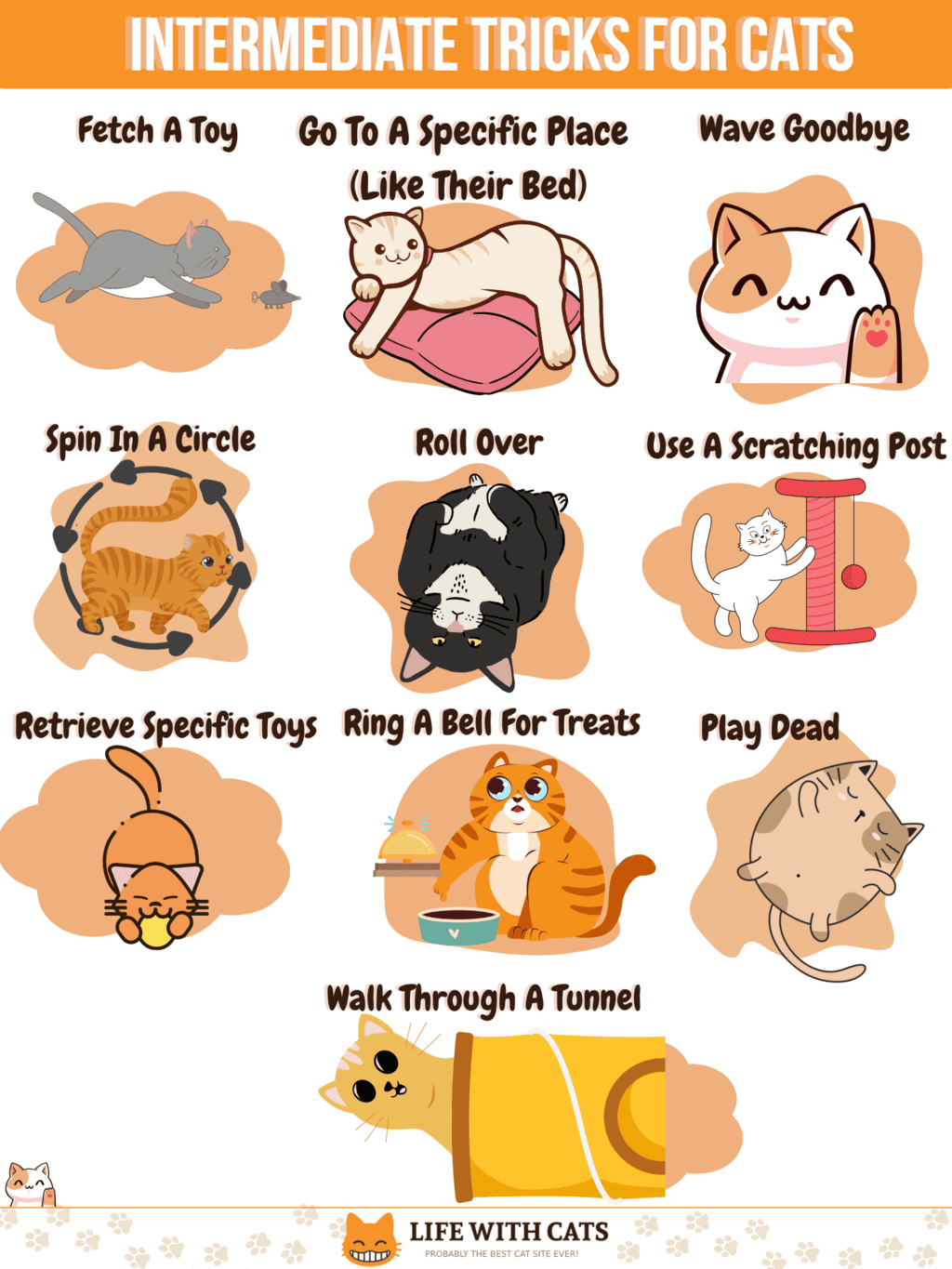
Intermediate tricks for cats are slightly more challenging commands than the basics. Always ensure that your cat is confident in the basic tricks before you teach her the intermediate ones.
Fetch A Toy
This trick involves teaching your cat to bring you one of her toys. Choose a lightweight toy that is easy for your cat to carry and is ideally one of her favorites.
- Start by playing with the toy near your cat and encouraging them to play with it.
- Next, toss the toy a couple of feet away from you and encourage your cat to approach it.
- As soon as your cat touches or picks up the toy, reward her with a treat and praise her.
- Once your cat is happy to play with the toy, encourage her to bring it to you. Use a simple cue, such as “bring it.”
- Every time your cat brings the toy to you, give her a high-value treat or spend more time playing with her favorite toy. That reinforces the behavior, making your cat more likely to repeat it.
- Once your cat is familiar with the game, you can extend the distance that you throw the toy. Always reward your cat when she brings the toy to you.
Use A Scratching Post
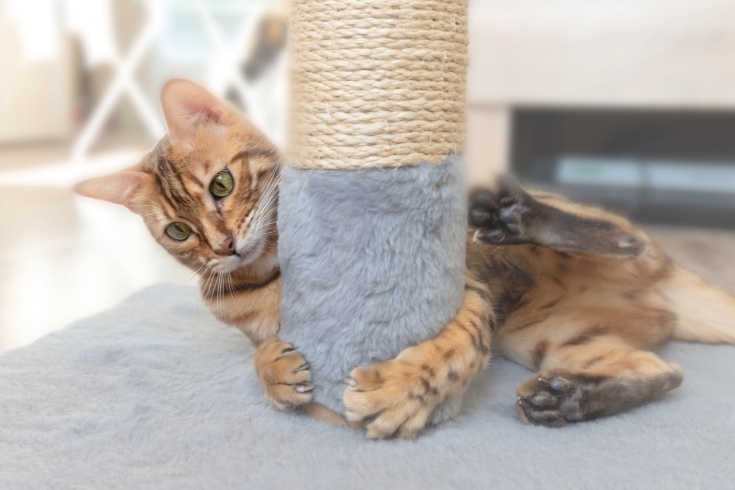
Teaching your cat to use a scratching post will help prevent damage to your furniture and provide your pet with a natural outlet for stress.
Choose a tall post mounted in a firm base so that it doesn’t topple over when your cat uses it, and place the post close to a spot where your cat likes to scratch.
- Sprinkle some catnip on the post or hang one of your cat’s favorite toys near it to get your cat interested. When your cat shows interest in the scratching post, immediately reward her with a treat and praise.
- Regularly sprinkle more catnip on the scratching post or rub it with treats to keep your cat interested.
If you catch your cat scratching on your furniture or floor coverings, immediately tell her ”No!” and redirect her attention to the scratching post.
Spin In A Circle
Spinning in a circle is a cute trick to teach your cat that is sure to impress your friends and family!
- Start by choosing a simple hand signal, such as a circular motion with your hand, and decide on a verbal command, such as “spin.”
- Hold a high-value treat close to your cat’s nose, and move it slowly in a circular motion, using the hand signal you have chosen. The cat should follow the treat and turn in a circle. As soon as your cat completes the spin, reward her with a treat.
- Repeat the exercise a little and often until your cat is consistently spinning in response to your verbal cue and hand gesture.
Wave Goodbye
Teaching your cat to wave a paw is a fun and entertaining trick that’s sure to raise a smile.
- Choose a visual cue that you can use to tell your cat to wave goodbye. That could be a hand gesture and use a verbal command, such as ”Bye, bye.” Show your cat the hand gesture, as well as give the verbal cue.
- Now, gently hold your cat’s paw and move it in a waving motion. Immediately, reward your cat with lots of praise and treats.
- Gradually stop holding your cat’s paw and use your hand gesture further away from her while giving your verbal cue. Remember to praise her and treat her when your cat moves her paw.
- Eventually, with plenty of practice, your cat will start to mimic your hand-waving gesture with her paw.
Walk Through A Tunnel
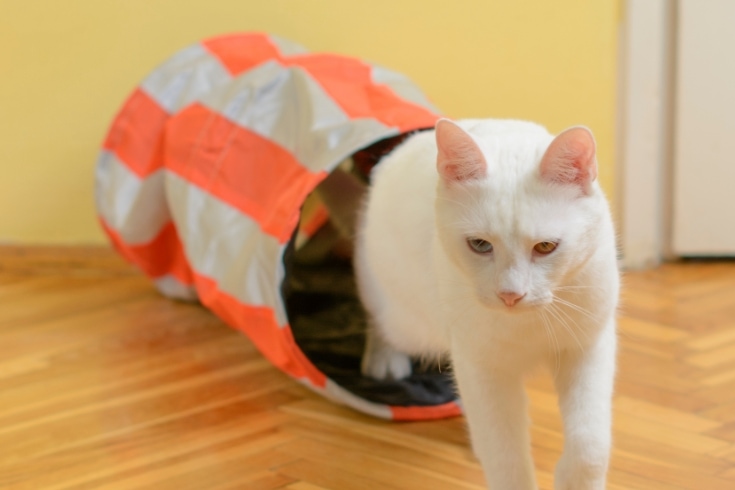
In this dog agility trick, you ask your cat to walk through a tunnel on command. Cats tend to negotiate tight spaces naturally, so this trick should be a breeze for your kitty!
Use a tunnel that’s specially designed for cats, and place it in an open, spacious area in your home.
- Start by tempting your cat into the tunnel using her favorite toy or a few treats at the entrance or just inside the tunnel.
- As soon as your cat enters the tunnel and starts to walk through it, give her lots of praise and a treat. That way, your cat will associate entering the tunnel with a positive experience and will be more likely to do so again in the future.
- Sometimes, the cat might only go into the tunnel partially, but if you keep practicing and using treats and toys to encourage your cat to go further in, she should eventually walk right through it.
Ring A Bell For Treats
You can use this trick to teach your cat to ring a small bell when she wants a treat or wants to go outside.
- Place the bell on a flat surface where your cat can investigate it, and allow your cat to sniff the bell and get familiar with it.
- Ring the bell and give your cat a treat. Repeat that process several times so that your pet begins to associate hearing the bell with getting a reward.
- Whenever you see your cat by the bell, gently take her paw and tap the bell with it. Immediately reward your cat with a treat and lots of praise.
- Repeat the process until your cat starts tapping the bell without interaction from you, and be ready to reward her with a treat immediately. Eventually, your cat will get the idea and will ring the bell whenever she wants a treat or to go outside.
Retrieve Specific Toys (By Name)
Once your cat has learned to retrieve a toy, you can start teaching her to associate specific toys with their names; in this example, we’ll use a toy mouse.
- Start by playing with the toy mouse, encouraging your cat to join in, and constantly using the toy’s name.
- Put away your cat’s other toys and focus on interacting with her only with the mouse.
- Now, try putting the toy mouse alongside another toy and asking your cat to bring you the mouse. Every time the cat brings the mouse to you, reward her with a treat and plenty of petting and praise.
- Eventually, you can teach your cat names for other toys, making the challenge more difficult.
Go To A Specific Place (Like Their Bed)

You can teach your cat to go to a particular place, such as her bed, which is useful at night, or if you want to keep your pet away from visitors who might not like feline attention.
- Choose a cue word that your cat can learn to associate with wherever you want her to go.
- Encourage your cat to go to the desired location using a target stick or treats, and reward her immediately when she does as you ask.
- Repeat the process until your cat is confidently heading to the desired place to get a reward. Only reward your cat when she goes to the target location so that she learns to associate doing so with a treat.
Roll Over
Teaching your cat to roll over on command can be handy for grooming purposes and when checking your cat for ticks and fleas.
- When your cat is lying on the floor with plenty of space around her, kneel beside your feline friend and start petting her.
- Your cat will likely lean toward your hand and rub her face against you. Now, reach over your pet and start rubbing your hand on the floor. Your cat will probably roll toward your hand for more fuss.
- Repeat the process, using a verbal cue at the same time, and give your pet a treat when she rolls over.
- Eventually, and with practice, your cat will roll over on cue to receive more petting and treat rewards.
Play Dead
Play dead is a trick that’s mostly associated with dogs, although cats can sometimes learn to do it to.
- Wait until your cat is lying stretched flat out, give your chosen verbal command, such as “play dead,” and give your cat a treat.
- Add a hand gesture, such as pointing your finger, and give the verbal command, rewarding your cat with a treat.
- Repeat the process, gradually asking your cat to play dead for longer periods.
Advanced Tricks For Cats
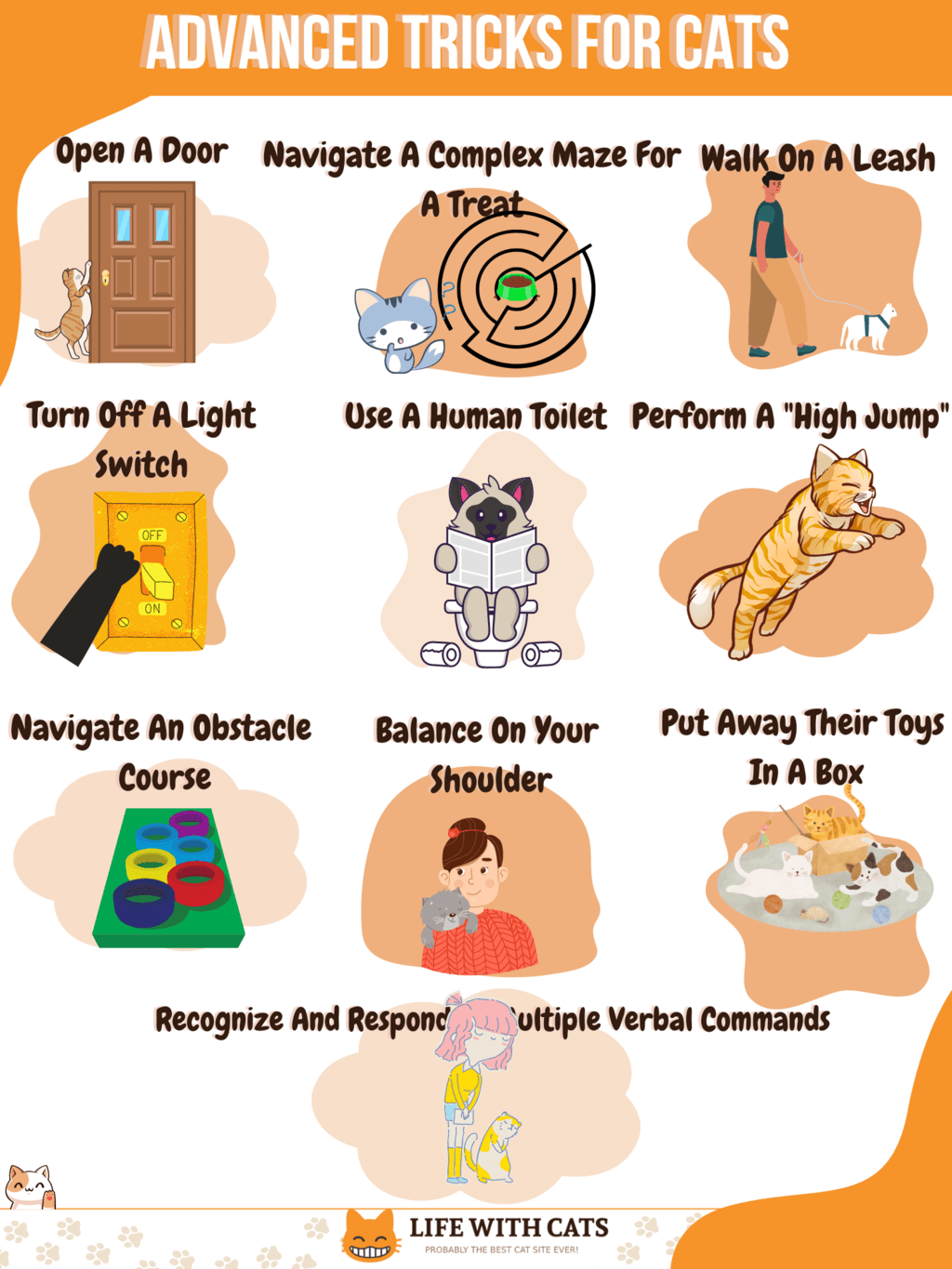
Now that your cat has mastered the basic and intermediate-level commands, you can move on to teaching her the most challenging tricks. All cats have limits when it comes to their learning abilities, so don’t try to force your cat to do any of these tricks if she doesn’t want to.
Open A Door
If your cat can open a door on command, that will save you from getting up and letting her out of the room!
Be sure to choose a lightweight door that swings freely and is easy for your cat to push.
- Using a target stick, encourage your cat to come close to the door and touch it for a treat reward. Repeat that process until the cat understands what you want her to do.
- Encourage the cat to stand up and put her weight against the door so that it swings open. Immediately reward your pet with a treat.
- Choose a verbal cue, such as “open the door,” and use it whenever you want your cat to open the door.
Turn Off A Light Switch
This is a pretty neat trick you can teach your cat, provided you have a light switch she can reach!
- Encourage your cat to investigate the light switch, providing verbal encouragement and plenty of praise.
- Choose a verbal command and use it consistently when you turn the light off, and your cat is within earshot.
- Gently take your cat’s paw and press it on the light switch, remember to use your chosen verbal cue, and give your cat plenty of praise and treats.
- Over time, release your cat’s paw earlier in the process and encourage her to press the switch herself in exchange for a treat.
- Repeat the process often until your cat understands what you want her to do, and gradually reduce treating her once the penny has dropped.
Walk On A Leash
Training your cat to wear a harness and walk on a leash are invaluable skills that your cat will need to learn if she’s an indoor cat or if you live in a heavy-traffic area where it’s not safe for your cat to roam outside.
- Ensure your cat’s harness fits properly so that she’s comfortable. Don’t use a collar and leash combo, as that can cause injury if your cat pulls back hard.
- Get the cat used to wearing her harness, rewarding her with plenty of treats and praise.
- Fix a short, lightweight leash to the harness and allow the cat to explore inside your home.
- Use toys, a lure, and treats to encourage your cat to walk on the leash, ignoring any resistance and rewarding your pet when she walks confidently beside you.
- Now you can progress to walking your cat in a small enclosed outdoor area, such as a patio. Allow your cat to sniff around and take in the unfamiliar sights and sounds, remembering to reward her when she walks calmly on her leash.
- Walking on a leash is not something that cats do naturally, so be patient, take your time, and don’t force your cat to walk if she’s not confident.
Navigate An Obstacle Course
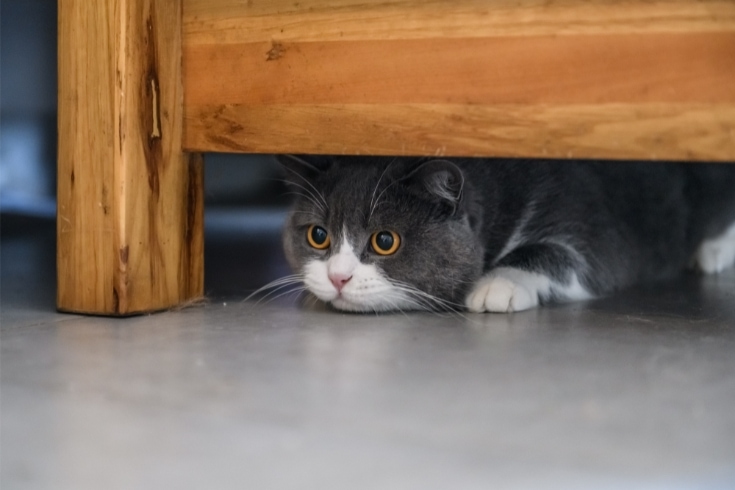
Cats are agile creatures that enjoy jumping and exploring tight spaces, so negotiating an obstacle course should come as second nature to your pet.
You can use any kind of obstacles, including weird surfaces, such as foil or bubble wrap, tunnels, and little jumps for your cat to navigate. This challenge is an excellent way of providing your cat with more mental and physical exercise, making it ideal for indoor cats.
- Set out the course in an area of your home where your cat feels comfortable and safe.
- Use a target or lure to encourage your kitty to move around the course, breaking it down into one obstacle at a time, and reward your cat each time she successfully negotiates an obstacle.
- Link the obstacles together until your cat can navigate the entire course, remembering to reward her every time she completes the course.
Perform A “High Jump”
The cat high jump is another advanced trick that comes as second nature to cats!
- Choose one of your cat’s favorite toys and spend some time playing with your pet so that she’s excited and keen to grab the toy.
- Now, hold the toy up at waist height, and encourage your cat to leap up and grab it, rewarding her with praise, treats, and her desired toy when she does so.
- Next, repeat the process, but hold the toy a little higher.
- Up the ante by suspending the toy in a doorway so that your cat has to make a high jump to get it.
Balance On Your Shoulder
Teaching your cat to balance on your shoulder is best done when the cat is a kitten. I once had a neighbor who regularly walked down the street with his cat on his shoulder to buy his daily paper from our local newsagent, which certainly turned a few heads!
- Start by lifting the cat onto your shoulder a few times for just a few seconds, using positive reinforcement, plenty of praise, and treats.
- Repeat the process, gradually increasing the duration of the shoulder balancing until your cat is confident to sit there in exchange for treats.
- Make the trick more difficult by walking around the room. Cats have exceptional balance, so your cat will most likely stay on your shoulder quite comfortably.
Use A Human Toilet

Training your cat to use a human loo saves you the expense and hassle of maintaining a litter box. You’ll need to invest in a kitty potty training kit for this trick.
- Relocate your cat’s litter box to your bathroom so that your pet gets used to going there to relieve herself.
- Put the loo seat down and set the litter box on it. That effectively teaches the cat to sit on the toilet to do her business.
- Once your cat is regularly using the litter box on the loo, switch it out for the potty training kit.
- When your cat starts using the kitty loo, give plenty of praise and treats.
Bear in mind that some cats like to bury their feces and won’t use a cat toilet seat. Also, elderly cats with joint pain can find jumping on and off the loo uncomfortable, which can lead to toileting problems.
Put Away Their Toys In A Box
If your cat has lots of toys, training her to put them away in a box saves you the trouble of tidying away after every playtime!
- Stand by the toy box with a pouch of treats and ask your cat to come to you. Reward her with a treat and toss one of her favorite toys a few feet away from the box.
- Command your cat to fetch the toy. When she brings the toy to you and drops it at your feet, reward her with praise and treats.
- Repeat the process, but offer your cat a treat in the toy box this time. Your cat should drop the toy into the box to take the treat.
- Up the ante by sending your cat to fetch specific toys and ask her to drop them into the toy box in return for a treat.
Navigate A Complex Maze For A Treat
Cats have a keen sense of smell, and you can use that to encourage your cat to find her way through a complex maze for a treat. This trick will be a breeze if your cat is used to playing with puzzle toys!
- Start by setting out a maze for your cat using boxes, and place treats at regular intervals throughout the maze.
- Introduce your cat to the maze, encouraging her to look for the treats by showing her where the first few are.
- Reset the maze, and repeat the process.
- Once your cat has caught onto the game, make the maze more complex and reduce the number of treats until there’s only one at the end of the maze.
Recognize And Respond To Multiple Verbal Commands
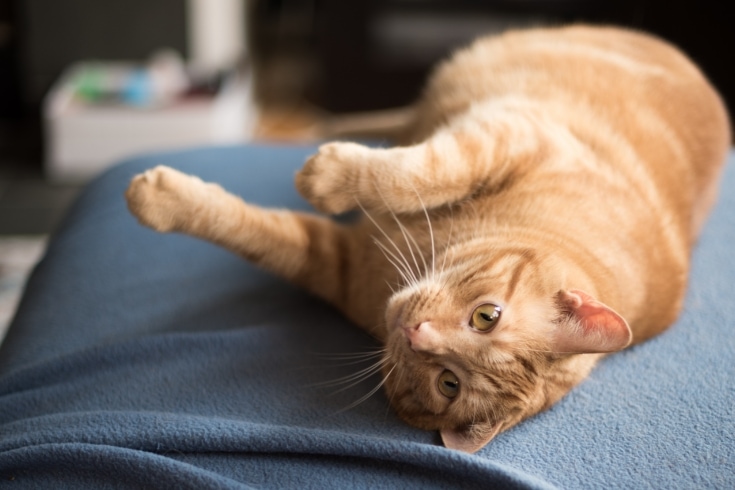
By this stage in your cat’s training, she will know many verbal and physical cues, and you can string some of them together to create a series of advanced tricks and challenges.
For example:
- Ask your cat to sit and stay.
- Move away from your cat, have her wait for a few seconds, and then call her to come to you.
- Have your cat lie down and roll over.
- Take one of your cat’s favorite toys, throw it away from you, and ask her to retrieve it.
- Ask your cat to jump onto your shoulder and balance there for a few minutes.
Of course, you can use any combination of the tricks and cues your cat has learned to make playtime more interesting!
What Are The Benefits of Teaching Tricks To Cats?
The benefits of teaching tricks to cats are many but can include providing mental and physical stimulation to your pet, improving behaviors, making your cat easier to manage in an emergency and on vet visits, helping to build a bond between you, and can enable you to spot underlying health problems in your pet.
Mental Stimulation
Teaching your cat tricks provides mental stimulation for your pet, helping to relieve boredom and keep frustration at bay.
Physical Excercise
Many cats, especially indoor felines, don’t get enough exercise, which can lead to unhealthy weight gain. Incorporating tricks into your cat’s daily routine can help to provide your pet with valuable physical exercise.
Strengthens Bond

Working with your cat to teach her tricks and commands helps to strengthen the bond between you, leading to a more fulfilling, loving owner-pet relationship.
Develop Social Skills
Learning to work with you helps to build a better social skill set for your cat so that she gets along better with other members of your household, including pets.
Improves Behavioral Problems
Teaching your cat tricks can help to improve behavioral problems such as aggression and damaging your furniture. For example, learning to use a scratching post will stop your cat from sharpening her claws on your carpets.
Easier To Manage In Emergency
Simple tricks, such as learning to come to you when you call her, will make your cat much easier to manage in an emergency situation.
Easier Vet Visits
Tricks, such as lying down, rolling over, and traveling in a cat carrier, can make veterinary visits go more smoothly.
Increase Confidence
If you have a shy cat, learning to perform simple tricks can help to increase your pet’s confidence and bring her out of her shell.
Form Of Play
Many cats and kittens view learning tricks as a form of playtime that you can incorporate into their daily routine.
Sense Of Accomplishment

Training your cats to perform tricks gives you a tremendous sense of achievement and is definitely something that will impress your friends and family!
Better Understanding Of Cat Personality
Although many cats look very similar, they all have different personalities, and training your cat to perform tricks can help you understand how your cat ticks.
Promotes Routine
We know that cats thrive on a regular routine, and incorporating training time into your cat’s day can promote a sense of security in your pet.
Improve Communication
There is no doubt that working with your cat to teach her different tricks and commands helps to improve communication between you.
Enable Early Detection Of Health Issues
The more time you spend with your cat and the more tricks you ask her to do, the easier it becomes for you to detect health issues that could be brewing.
For example, a cat that previously enjoyed jumping through hoops and suddenly refuses to do so could have early-onset joint pain or arthritis.
Enhance Quality Of Life
Cats are intelligent creatures that need plenty of mental and physical stimulation to be happy. By teaching your cat tricks, you’re providing him with everything he needs for an enhanced quality of life.
How Do You Prepare For Teaching Cat Tricks?

Teaching your cat tricks is undoubtedly challenging and is something you must prepare for by learning how to understand your cat and ensuring she’s fit and healthy.
You’ll need to gather the right training tools and know how to use them and decide on what tricks you want to teach your cat. Plan to make gradual progress with your cat and be ready to keep training sessions short and within your cat’s ability.
These are the steps to prepare your cat to learn new tricks.
Understand Your Cat
All cats are different, and you must understand your cat’s individual personality before you begin trying to teach her tricks.
Health Check
Before you start your training program, it’s essential that you have your cat’s health checked by your vet so that you know your cat is fit, healthy, and pain-free.
Choose The Right Time
Your cat won’t concentrate or be receptive to learning if she’s hungry, tired, or in the mood for a game, so be sure to choose the right time for your training sessions.
Create A Distraction-Free Environment
A distraction-free environment is essential for training sessions so that your cat remains focussed on you throughout.
Gather Training Tools
Don’t start a training session without everything you need on hand! If you have to leave the room to fetch something, your cat will switch off and you’ll have to work twice as hard to refocus her on the lesson you’re teaching.
Start With Short Training Sessions
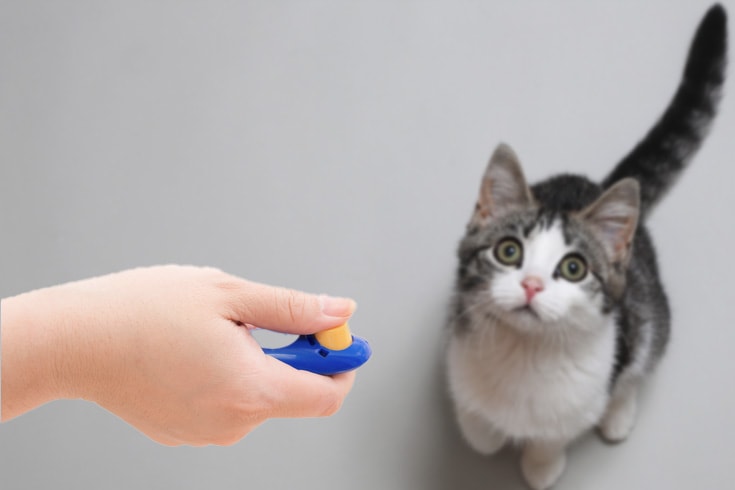
Learning new tricks can be mentally and physically challenging for your cat, so keep your training sessions short and frequent rather than having one long session.
Establish A Consistent Routine
Cats love routine, so build your training sessions into your cat’s daily schedule. That way, you know that your cat will be fed, relaxed, and ready to learn.
Practice Patience
Some cats learn quicker than others, so you must be patient if your cat is a slow learner and be prepared to invest time establishing the simplest tricks and cues before moving on to the more challenging ones.
Decide On The Tricks
Have a structure to your training plan, starting with the easiest tricks and only moving on to the more difficult, advanced ones when your cat is comfortable with the basics.
Positive Reinforcement
Always use positive reinforcement and reward-based training methods when teaching your cat tricks. That way, your pet learns that she will receive a tasty treat, praise, or petting when she displays the behaviors you want.
Understand Cat Body Language
Cat body language can tell you much about the cat’s mood and gives you a good indication of how receptive she will be to a training session. So, take time to understand your furry friend’s body language before you being training her.
Build Trust
Some of the tricks you’ll be teaching your cat demand a degree of trust between you, such as riding on your shoulder.
So, be sure to build trust between the two of you before you begin working together on tricks.
Provide Plenty Of Rest

Training sessions can be physically and mentally demanding. Be sure to provide your cat with plenty of rest periods, and don’t keep pushing on when your pet is clearly mentally or physically tired.
Plan For Gradual Progress
When it comes to cat training, slow and steady wins the race! Be prepared to make gradual progress so that your cat has mastered the basics before moving on to more challenging tricks.
Consult A Professional
If you find yourself struggling to train your cat or she has behavioral issues, such as aggression, always be ready to admit defeat and consult a professional animal behaviorist or trainer for advice and help.
What Tools Are Needed In Teaching Cat Tricks?
These are the tools you’ll need to teach your cat tricks.
Item
Description/Used For
Clicker
A handheld device that makes a clicking sound when pressed. Used to reinforce verbal or physical cues.
Treats
Tasty food morsels. Used to reward desirable behavior.
Laser Pointer
Pen-like device with laser light. Used to direct a cat’s attention.
Training Mat
Mat with soft “spikes” or mild electric pulse. Used to deter cats from walking in certain areas of your home.
Training Tunnel
A hollow tube large enough for the cat to walk through. Used to teach the cat to walk through a tunnel.
Catnip Toys
Various cat toys stuffed with catnip. Used to entice the cat to play with the toy.
Interactive Toys
Various toys that are used to encourage cats to play with their owners.
Feather Wand
Fishing pole-type wand with feathers attached to the end. Used to encourage interactive play.
Leash and Harness
Small, cat-sized harness and lightweight leash that are used to teach the cat to walk alongside her owner.
Scratch Post
Sturdy sisal-covered post for cats to scratch on, preventing damage to home furnishings and satisfying cats’ natural behavior.
Agility Equipment
Various items, such as hoops and hurdles. Used to teach cats agility tricks.
Training Bells
Small bells that ring when the cat taps the device with her paw. Used to train a cat to ring the bell when she wants to go outside or wants a treat.
Puzzle Feeders
Puzzle feeders are interactive toys that encourage the cat to search for treats by solving simple problems.
Reward Pouch
A small pouch used to contain treats and other food rewards.
What Are Useful Tips For Teaching Tricks To Cats?
Useful tips for teaching tricks to cats include using positive reinforcement techniques, keeping training sessions short, respecting your cat’s limits, and settling for gradual progression rather than expecting too much too soon.
Positive Reinforcement
Always use positive reinforcement when training your cat to perform tricks. That approach helps your cat to understand that she will receive a reward for displaying desired behaviors.
Short Training Sessions
Keep your training sessions short so that your cat doesn’t get bored and lose interest.
Consistent Commands
Always keep your verbal and physical cues consistent so that your cat doesn’t get confused.
Patience
Cats learn at different rates, and some are quicker to learn than others, so be patient when training your cat tricks.
Regular Practice

When it comes to teaching cats tricks, regular practice is the key to success! If you take time to train your cat every day, she will be more likely to retain what you’ve taught her.
Non-Verbal Cues
Use gestures as non-verbal cues to show your cat what you want her to do.
Respect For Cat’s Limits
Understand and respect your cat’s limits and don’t demand too much from her.
Gradual Progression
Be happy to make gradual progress in your training sessions rather than trying to push your cat for too much too soon.
Distraction-Free Environment
Your cat will learn better in an environment that’s quiet and free from distractions.
Reward Immediately
Reward your cat immediately when she gets it right. That way, your pet will anticipate and crave a reward for displaying good behavior.
Variability Of Rewards
You can reward your cat with edible treats, verbal praise, and fuss, so keep your cat interested by varying the rewards she receives.
Training Routine
Build training sessions into your cat’s routine so that she knows when it’s time to play, have fun, and learn.
Regular Breaks
Be ready to give your cat regular breaks during her training sessions. That prevents your pet from becoming mentally and physically tired and keeps the training sessions fun.
What Are The Challenges When Teaching Cat Tricks?

The challenges when teaching cat tricks are many and varied both for you and your pet!
Lack Of Interest
Your cat might lose interest in her training sessions. That makes it difficult to keep your pet’s attention throughout your training, making it harder to teach her tricks.
Short Attention Span
Cats are like small kids in that they have a very short attention span and are easily distracted, so you’ll need to be patient and prepared to keep your training sessions brief.
Inconsistent Behavior
Cats tend to behave inconsistently. Sometimes, your cat will be focused and quick to learn, whereas at other times she might be totally disinterested or mischievous.
Lack Of Motivation
Some cats are not interested in learning tricks. Period! So, it’s up to you to motivate your cat to learn by offering treats, praise, and whatever rewards float your cat’s boat.
Overstimulation
Sometimes your cat will get so excited during training, she stops learning and just wants to have fun!
Fear Or Anxiety
Be careful not to frighten your cat when teaching her new tricks. For example, some cats might be afraid of walking on a leash or sitting on your shoulder.
Distractions
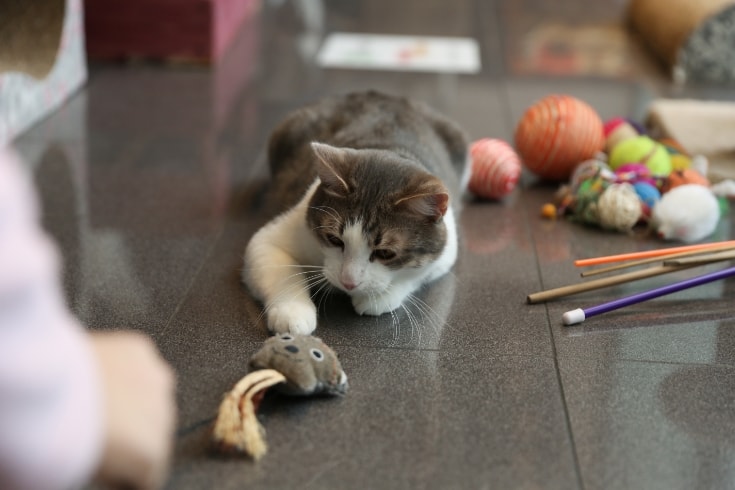
Cats are easily distracted, so use an environment that’s quiet and free from interruptions.
Aggression
Some cats become aggressive when overstimulated, making them impossible to train.
Misinterpretation Of Commands
If some of your verbal cues or commands sound or look similar, your cat could misinterpret them.
Health Issues
Health issues might mean that your cat cannot physically perform some tricks.
Aging And Slower Learning
Senior cats often learn slower than younger ones, so be prepared to accept that and take your time.
Reluctance To Try New Things
If you have an older cat, she might not be keen to learn new tricks.
Difficulty In Understanding Complex Tricks
Some cats are brighter than others, that’s just a fact. Your cat might do well with simple tricks but could struggle with more complex ones.
Overeating Due To Treat-Based Rewards
Don’t go overboard with edible treats or your cat could start to gain weight!
Reverting To Old Habits
If you don’t keep up with cat training, your pet could revert to her old behaviors.
FAQs
What Is The Easiest Trick To Teach A Cat?
I think the easiest trick to teach your cat is to come when called. Most cats of all ages learn to recognize their name and quickly associate coming when called with receiving praise and a treat.
How Many Commands Can A Cat Learn?
The number of commands a cat can learn depends on the individual cat’s learning ability, personality, and temperament, and on how much time you have to devote to her training.
Can I Teach My Kitten Tricks?
Kittens can learn lots of cool tricks, as they typically absorb new experiences and commands like sponges! So, yes, you can teach your kitten tricks, but keep training sessions short, and don’t expect too much too soon.
Can I Teach My Senior Cat Tricks?
Senior cats can learn simple tricks, but be sure to check that your pet is physically fit and not in discomfort before you begin training.
In addition, older cats might be set in their ways, so teaching your pet new tricks could take longer than younger cats.
What Do Cats Like The Most?
In my experience, most cats love the rewards that come with learning tricks and the playtime training often equates to.
Is It OK To Spray A Cat With Water?
Spraying your cat with water as punishment won’t effectively change her behavior and will probably make her afraid, stressed, and resentful. So, we don’t recommend spraying your cat with water.
Can Cats Do Any Tricks?
Yes! As you’ve read in this guide, you can teach cats to do plenty of cool tricks.
Can A Cat Learn “No”?
Yes, your cat can learn the “No” command quite easily. In fact, that’s one of the first commands I taught my cats when they were kittens to discourage undesirable behaviors around my home. Remember to reinforce good behaviors with praise and treats!
Conclusion
I hope you enjoyed our guide on 30 tricks you can teach your cat. If you did, please remember to hit the share button before you go!
Cats can learn basic, intermediate, and advanced tricks through patient, positive reinforcement training methods and the use of various training tools and devices. When training your cat, always begin with the most basic tricks, keep training sessions short, choose a quiet, distraction-free environment for your training sessions, and give your cat regular breaks so that she doesn’t get tired.
What tricks did you teach your cat? Tell us about your feline friend in the comments box below!